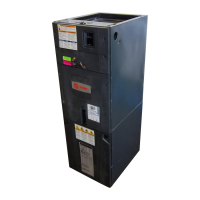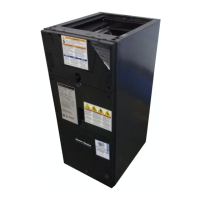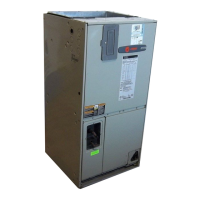26
Section 12. Condensate Drain Piping
12.2 Connect Condensate Drain Piping
STEP 1 - Select the drain connections that are ori-
ented for your application.
STEP 2 - Prepare the condensate drain connections.
From the factory, the unit comes with plugs in both •
upflow condensate drains and an additional plug in
the documentation packet.
For upflow applications, remove upflow condensate •
plug(s) and connect condensate piping.
For all other applications, do not remove upflow •
condensate plugs. Remove the cover from the
needed condensate drain connections and connect
condensate piping.
If the secondary drain connection is not used, close •
secondary drain with plug from documentation
packet (all applications except for upflow).
Note: Upflow and horizontal orientations require the
Coil panel to be removed in order to make the drain
connections. Note: Make certain that the unit has
been installed in a level position to allow for proper
draining.
STEP 3 - Connect 3/4” PVC pipe to the primary drain
connection (and the secondary drain connection if
used) using threaded drain nipples.
Use Teflon tape on the air handler drain line con- •
nections. Do not use pipe joint compound or PVC/
CPVC cement on drain nipple.
Hand tighten the drain pipe. •
Horizontal Left
Condensate Drains
Upflow
Condensate
Drains
Downflow
Condensate
Drains
Horizontal Right
Condensate Drains
S P
S
P
S
P
S
P
Drain Nipple
3/4” PVC pipe
Teflon Tape
PVC/CPVC Cement
12.1 Condensate Drain Piping Considerations
Condensate drain plumbing must comply with na- •
tional, state, and local codes.
Route condensate drain lines away from air handler •
so they do not interfere with access panels.
Slope the drain lines downward a minimum of 1/4” •
per foot, support per local codes.
Do not use reducing fittings in the condensate drain •
lines.
Do not connect the drain line to a closed drain •
system.
Do not use a torch or flame near the plastic drain •
pan coupling.
A P-trap is not required for proper drainage due to •
the positive pressure of the air handler; however,
it is recommended to prevent efficiency loss of
conditioned air.

